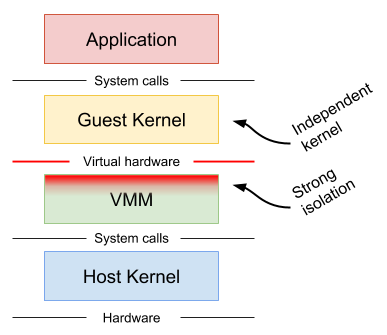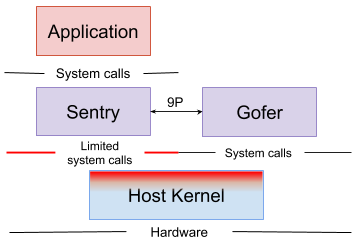What is gVisor?
gVisor provides a strong layer of isolation between running applications and the host operating system. It is an application kernel that implements a Linux-like interface. Unlike Linux, it is written in a memory-safe language (Go) and runs in userspace.
gVisor includes an Open Container Initiative (OCI) runtime called runsc
that makes it easy to work with existing container tooling. The runsc runtime
integrates with Docker and Kubernetes, making it simple to run sandboxed
containers.
gVisor can be used with Docker, Kubernetes, or directly using runsc. Use the
links below to see detailed instructions for each of them:
- Docker: The quickest and easiest way to get started.
- Kubernetes: Isolate Pods in your K8s cluster with gVisor.
- OCI Quick Start: Expert mode. Customize gVisor for your environment.
What does gVisor do?
gVisor provides a virtualized environment in order to sandbox containers. The system interfaces normally implemented by the host kernel are moved into a distinct, per-sandbox application kernel in order to minimize the risk of a container escape exploit. gVisor does not introduce large fixed overheads however, and still retains a process-like model with respect to resource utilization.
How is this different?
Two other approaches are commonly taken to provide stronger isolation than native containers.
- gVisor is not a syscall filter (e.g.
seccomp-bpf), nor a wrapper over Linux isolation primitives (e.g.firejail, AppArmor, etc.). - gVisor is also not a VM in the everyday sense of the term (e.g. VirtualBox, QEMU).
gVisor takes a distinct third approach, providing many security benefits of VMs while maintaining the lower resource footprint, fast startup, and flexibility of regular userspace applications.
Let’s take a closer look.
Machine-level virtualization, such as KVM and Xen, exposes virtualized hardware to a guest kernel via a Virtual Machine Monitor (VMM). This virtualized hardware is generally enlightened (paravirtualized) and additional mechanisms can be used to improve the visibility between the guest and host (e.g. balloon drivers, paravirtualized spinlocks). Running containers in distinct virtual machines can provide great isolation, compatibility and performance (though nested virtualization may bring challenges in this area), but for containers it often requires additional proxies and agents, and may require a larger resource footprint and slower start-up times.

Rule-based execution, such as seccomp, SELinux and AppArmor, allows the specification of a fine-grained security policy for an application or container. These schemes typically rely on hooks implemented inside the host kernel to enforce the rules. If the surface can be made small enough, then this is an excellent way to sandbox applications and maintain native performance. However, in practice it can be extremely difficult (if not impossible) to reliably define a policy for arbitrary, previously unknown applications, making this approach challenging to apply universally.

Rule-based execution is often combined with additional layers for defense-in-depth.
gVisor provides a third isolation mechanism, distinct from those above.
gVisor intercepts application system calls and acts as the guest kernel, without the need for translation through virtualized hardware. gVisor may be thought of as either a merged guest kernel and VMM, or as seccomp on steroids. This architecture allows it to provide a flexible resource footprint (i.e. one based on threads and memory mappings, not fixed guest physical resources) while also lowering the fixed costs of virtualization. However, this comes at the price of reduced application compatibility and higher per-system call overhead.

On top of this, gVisor employs rule-based execution to provide defense-in-depth (details below).
gVisor’s approach is similar to User Mode Linux (UML), although UML virtualizes hardware internally and thus provides a fixed resource footprint.
Each of the above approaches may excel in distinct scenarios. For example, machine-level virtualization will face challenges achieving high density, while gVisor may provide poor performance for system call heavy workloads.
Why Go?
gVisor is written in Go in order to avoid security pitfalls that can plague kernels. With Go, there are strong types, built-in bounds checks, no uninitialized variables, no use-after-free, no stack overflow, and a built-in race detector. However, the use of Go has its challenges, and the runtime often introduces performance overhead.
What are the different components?
A gVisor sandbox consists of multiple processes. These processes collectively comprise an environment in which one or more containers can be run.
Each sandbox has its own isolated instance of:
- The Sentry, which is a kernel that runs the containers and intercepts and responds to system calls made by the application.
Each container running in the sandbox has its own isolated instance of:
- A Gofer which provides file system access to the containers.

What is runsc?
The entrypoint to running a sandboxed container is the runsc executable.
runsc implements the Open Container Initiative (OCI) runtime
specification, which is used by Docker and Kubernetes. This means that OCI
compatible filesystem bundles can be run by runsc. Filesystem bundles are
comprised of a config.json file containing container configuration, and a root
filesystem for the container. Please see the OCI runtime spec
for more information on filesystem bundles. runsc implements multiple commands
that perform various functions such as starting, stopping, listing, and querying
the status of containers.
Sentry
The Sentry is the largest component of gVisor. It can be thought of as a application kernel. The Sentry implements all the kernel functionality needed by the application, including: system calls, signal delivery, memory management and page faulting logic, the threading model, and more.
When the application makes a system call, the
Platform redirects the call to the Sentry,
which will do the necessary work to service it. It is important to note that the
Sentry does not pass system calls through to the host kernel. As a userspace
application, the Sentry will make some host system calls to support its
operation, but it does not allow the application to directly control the system
calls it makes. For example, the Sentry is not able to open files directly; file
system operations that extend beyond the sandbox (not internal /proc files,
pipes, etc) are sent to the Gofer, described below.
Gofer
The Gofer is a standard host process which is started with each container and communicates with the Sentry via the 9P protocol over a socket or shared memory channel. The Sentry process is started in a restricted seccomp container without access to file system resources. The Gofer mediates all access to these resources, providing an additional level of isolation.
Application
The application is a normal Linux binary provided to gVisor in an OCI runtime
bundle. gVisor aims to provide an environment equivalent to Linux v4.4, so
applications should be able to run unmodified. However, gVisor does not
presently implement every system call, /proc file, or /sys file so some
incompatibilities may occur. See Compatibility
for more information.